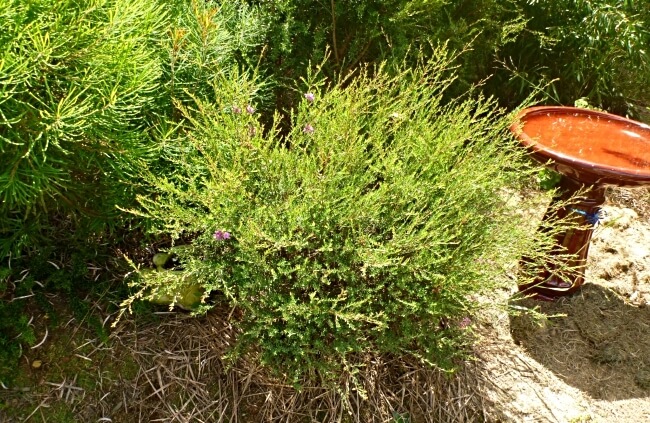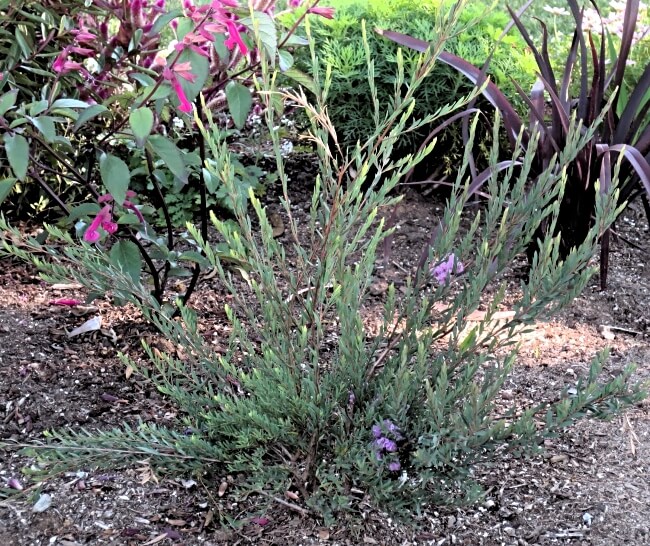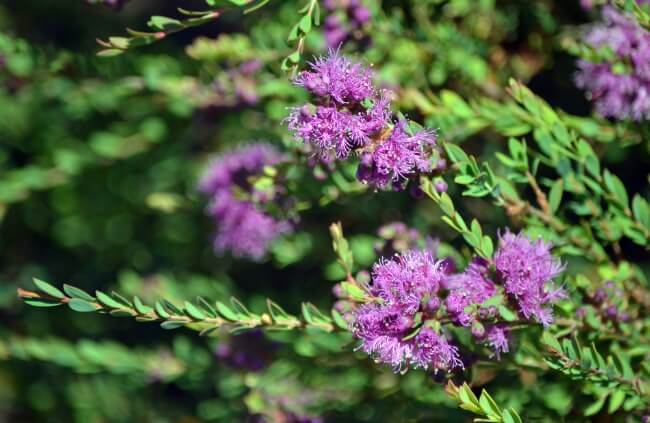One of Australia's most commonly cultivated melaleucas, Melaleuca thymifolia is a fragrant, spreading and compact evergreen shrub that features fine-leaved, blue-green foliage, flamboyant purple feathery flowers, and a fantastic form for residential gardening.
Prized for its fluffy purple-to-pink flowers that adorn the shrub in clusters throughout summer to autumn, this species is also highly adaptable to many climates and conditions, making it a perfect pick for almost any Australian garden looking for some native spectacle!
I'm thrilled to cover the remarkable Melaleuca thymifolia in today's growing guide! You'll find everything you need to know to grow and care for this native shrub, as well as a few additional tips to make the most of thyme honey myrtle in your garden.
More...

Source: Gardening With Angus
Family: | Myrtaceae |
|---|---|
Genus: | Melaleuca |
Species: | M. thymifolia |
Common names: | Thyme honey myrtle, Thyme leaf honey myrtle |
Origin: | Australian native |
Location: | Outdoor |
Type: | Shrub |
Growth: | 1 to 1.5 metres tall and wide |
Sun requirements: | Full sun |
Foliage colour: | Green |
Flower colour: | Purple flowers |
Flowering: | Summer to autumn |
Edible parts: | leaves and flowers can be used |
Maintenance level: | Low |
Poisonous for pets: | Plant oil is toxic to cats, dogs and horses if consumed |
Getting to Know Melaleuca thymifolia
Apart from its flowers, I believe this shrub has a lot going for it! Its spreading and dense form offers many useful ornamental landscaping applications for home gardening, and the delicate reddish young stems only add to the native plant's allure in outdoor spaces.
Enjoy bountiful rich mauve blooms for up to eight months of the year with honey myrtle Melaleuca thymifolia!
Like the close relative I covered almost 2 weeks ago, Melaleuca linariifolia, this species also forms a part of the Myrtaceae family of plants. Its common names include thyme honey myrtle and thyme leaf honey myrtle.
Native to eastern Australia, the shrub occurs from the Pigeon House Mountains in New South Wales, north to south-eastern and central Queensland. Thyme leaf honey myrtle is tolerant to many different Australian climates including sub-tropical, warm temperate, cool temperate, Mediterranean and coastal zones.
Cultivated in gardens, the plant will usually reach 1 to 1.5 metres tall and wide with a moderate growth rate. If you have a smaller cottage-style garden, the prized, smaller-growing cultivar Melaleuca thymifolia ‘Cotton Candy’ is an excellent alternative!
Common Uses for Thyme Honey Myrtle
The native shrub has many applications in residential gardens, regardless of where you live.
Here are some of the most common uses in Australia:
- Feature shrub
- Native screening and hedging
- Gap filling
- Rockery specimen
- Group plantings
- Great for native gardens and wildlife gardens
- Coastal gardening
How to Grow Melaleuca thymifolia
Thanks to the plant's notoriety throughout Australia, it can easily be found at many native plant nurseries, giving you a quick-to-establish young shrub! Alternatively, this species can be grown from seed or propagated using cuttings.
Propagating Thyme Honey Myrtle

Source: Dave's Garden
Propagating Melaleuca thymifolia from Seeds
Seeds can be collected from mature flower capsules and kept indoors in a bag until use. Seeds are best sown in spring to autumn, avoiding the coldest and hottest months. Prepare a container with a quality seed-raising mix or fertile potting soil. Lightly water then sow the seeds into the surface of the growing mix.
Press the seeds gently into the soil surface, being careful not to bury the seeds. Mist after sowing then keep warm and moist in a suitable location. The ideal temperatures for germination are 18-22°C. While the seeds grow, avoid letting the soil dry out or waterlogging the growing mixture.
Germination should occur within 3 weeks but some natives can remain dormant until conditions are favourable so you may need to be a little patient.
Propagating Thyme Honey Myrtle Using Cuttings
Cuttings can be taken from the plentiful branch tip growths from late summer to early winter. Try to snip off semi-hardwood cuttings from the current year's growth, with each cutting measuring about 12-14cm long. Semi-hardwood cuttings have hard bottoms and softer tops.
Using a sharp and sterilised knife or secateurs, take your cutting from a healthy, disease-free parent plant. Remove the lower leaves from the cuttings then dip the cut-end into a quality rooting hormone.
Prepare a well-draining container filled with a quality propagation mix or similar growing medium with compost, then place the cuttings into the mixture, firmly planting it around the pot. Water well after planting then place the cutting in a warm, sheltered location as it needs to remain moist until rooted.
A spot that gets semi-shade or healthy indirect light should work great. Keep the cutting moist and allow it to root properly before transplanting it into a larger container or garden bed.
Growing Conditions for Melaleuca thymifolia
As I mentioned earlier, this species is one of the most cultivated in its genus and there are good reasons for that! It is cherished for its fantastical flowers, graceful and useful form, and how adaptable it is to a wide range of growing conditions.
While it's not a fussy addition, there are certain growing conditions you can aim for to allow the shrub to thrive and look its best year-round!
Ideal Sunlight
If you want the best-looking, most fragrant flowers possible, this species needs full sun to encourage proper flowering. Pick a planting site that gets full sun for at least 6 hours a day (some afternoon shade may be appreciated in hotter climates). Full sun will ensure your shrub flowers for as long as possible!
Preferred Soil for Garden Beds
The shrub is tolerant to most soil types, both wet and dry. It is hardy to a range of planting conditions, even wet feet! However, it does prefer fertile, well-drained, and lime-free soil.
If you're concerned about the nutritional quality of your garden soil, you can always boost it by digging in some compost or well-rotted organic materials before planting.
Caring for Melaleuca thymifolia
Once established, the shrub is hardy to light frost and moderate drought. Overall, it requires very little care and maintenance, apart from an occasional good prune. Let's have a look at its basic care needs.

Source: Late to the Garden Party
- Watering - Water well when young and during hot and dry spells. Watering can be reduced slowly till autumn and in winter but aim to keep the soil from drying out, watering when it feels parched to the touch.
- Mulching - Add a layer of organic mulch around the base of the shrub from spring to summer to encourage good water retention and suppress weeds. When adding the mulch, try to avoid placing it directly onto the stem, rather leave some space so that the mulch creates a ring around the plant.
- Pruning - You will need to prune after flowering to encourage a compact and tidy growing habit. Be sure to also remove any dead or damaged branches as needed. Tip pruning can also be beneficial if new growth is getting a little messy.
- Fertilising - Fertiliser may not be necessary for favourable conditions but if you feel like your plant could benefit from a boost, you can add an organic native plant fertiliser that is low in nitrogen from spring to summer. Fertiliser can also help with shrubs that have become droopy or leggy.
Common Melaleuca thymifolia Problems
This long-lived species is resistant to most pests and diseases. Being so widely cultivated and adaptable to our endemic conditions, very little phases this hardy native! However, strong winds can become an issue.
Regular exposure to strong winds can cause the shrub to permanently lean or even dislodge entirely. If your area experiences fierce winds, you may need to pick a planting site that has some protection or plant alongside other native plants to act as a natural barrier.
Melaleuca thymifolia Bush Tucker Guide
While this species may not be our most famous bush tucker, it does certainly have some uses in the kitchen! The leaves and flowers can be used. The leaves produce a spicey, thyme-like aroma when crushed and the flowers produce a sweet nectar when steeped.
Here are some of my favourite ways to use thyme honey myrtle in the kitchen:
- Make a delicious infused honey or vinegar by steeping the leaves in a jar with honey or vinegar for a few weeks. You can use this to glaze roasted vegetables, add to marinades, or use in salad dressings for an added kick!
- You can use the flowers to make syrup or jelly by simmering them in water and sugar until they dissolve. Strain the mixture then store it in the fridge. For jelly, simply add some pectin to the mixture.
- The leaves can be added fresh to soups and stews, adding lovely spicy notes.
- The flowers can be used to garnish many dishes like desserts, cocktails, and a variety of savoury dishes!
- The flavours from this species can be rather strong, so when cooking with the leaves, be sure to use sparingly and taste as you go.
Melaleuca thymifolia Frequently Asked Questions

How big does Melaleuca thymifolia get?
In its natural habitat and native gardens, the shrub can reach over 1.5 metres high. However, when cultivated in gardens, it will typically grow to about 1-1.5 metres tall and wide.
Is honey myrtle edible?
Yes, the leaves and flowers of thyme leaf honey myrtle are edible and can be used in cooking. The leaves are commonly infused in oils and vinegars to add a spicy, thyme-like flavour whereas the blooms are used to make sweet syrups and jellies by steeping them in water and sugar.
Are Myrtle plants toxic to pets?
While more research is certainly needed regarding the genus toxicity in pets and animals, many species, including M. thymifolia have been reported to contain vinca alkaloids. These alkaloids are used in human medicines but are toxic to cats, dogs, and horses if ingested.
How long does Melaleuca thymifolia live for?
Growing conditions can largely influence how long this species lives, but on average, it can easily live for 10 to 20 years or more!
Does Melaleuca thymifolia attract wildlife?
The attractive flowers and fragrant foliage of this native shrub will attract many beneficial insects and nectar-loving birds to the garden.
How tall is Melaleuca thymifolia ‘Cotton Candy’?
This prized, smaller-growing cultivar is the perfect pick for smaller cottage-style gardens that need some native colour! It also produces the purple feathery flowers we love but only grows to about 50cm x 50cm.
Add Unparalleled Native Charm to Your Garden with Melaleuca thymifolia!
Suppose you're looking for an easy-going native shrub that can add exquisite colours and textures to your outdoor spaces. Well, I hope I've managed to assure you that Melaleuca thymifolia is certainly worth considering!
Whether for its feathery purple flowers, fantastic form, or fighting-fit nature, Melaleuca thymifolia clearly has lots to offer in Australian gardens!
Published on October 5, 2023 by Lorri Hopkins
Last Updated on April 15, 2024




